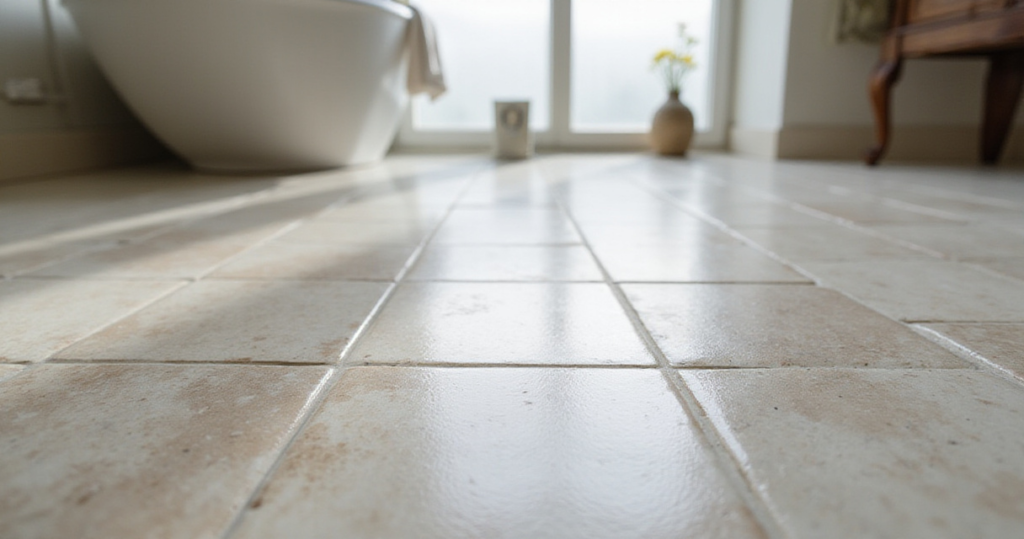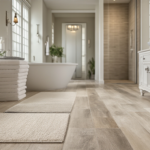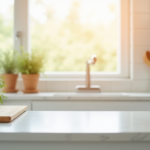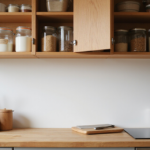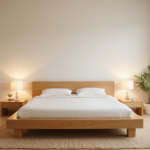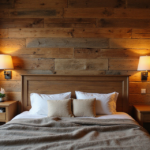Stepping into your bathroom shouldn’t feel like entering a cramped afterthought. Yet in most homes, the bathroom floor gets treated as an afterthought—a quick decision made from whatever’s cheapest or easiest to install. But here’s what I’ve learned after seven years of transforming tiny bathrooms: your floor choice can completely change how spacious, functional, and welcoming your bathroom feels.
The challenge with bathroom floor ideas isn’t just finding something that looks good. You’re dealing with moisture, limited square footage, potential slip hazards, and often a budget that’s already stretched thin from other renovation priorities. I’ve seen homeowners choose gorgeous materials that buckle within months, or opt for “practical” options that make their small bathroom feel even more cramped and institutional.
The good news? Modern materials and smart installation techniques have revolutionized what’s possible in bathroom flooring. Whether you’re working with a 30-square-foot powder room or trying to maximize a family bathroom that serves multiple people daily, there are solutions that deliver on both style and performance. Some of these options might surprise you—like how the right large-format tile can make a tiny bathroom feel twice its size, or how certain vinyl products now offer the warmth of wood with zero moisture worries.
In this guide, I’ll walk you through 23 bathroom floor ideas that I’ve tested in real small-space projects. Each option includes honest assessments of what works, what doesn’t, and how to make smart choices that will serve you well for years to come.
1. Choose Ceramic Tile for Reliable Water Protection on Any Budget
Ceramic tile remains my go-to recommendation for first-time renovators or anyone working with a tight budget who still needs bulletproof water resistance. When properly glazed, ceramic creates an impermeable barrier that shrugs off daily splashes, steam, and the occasional overflow from an overfilled tub. I’ve installed ceramic floors in rental properties that have weathered five years of tenant turnover without showing wear, and the maintenance requirements remain refreshingly simple—sweep regularly, mop occasionally, done.
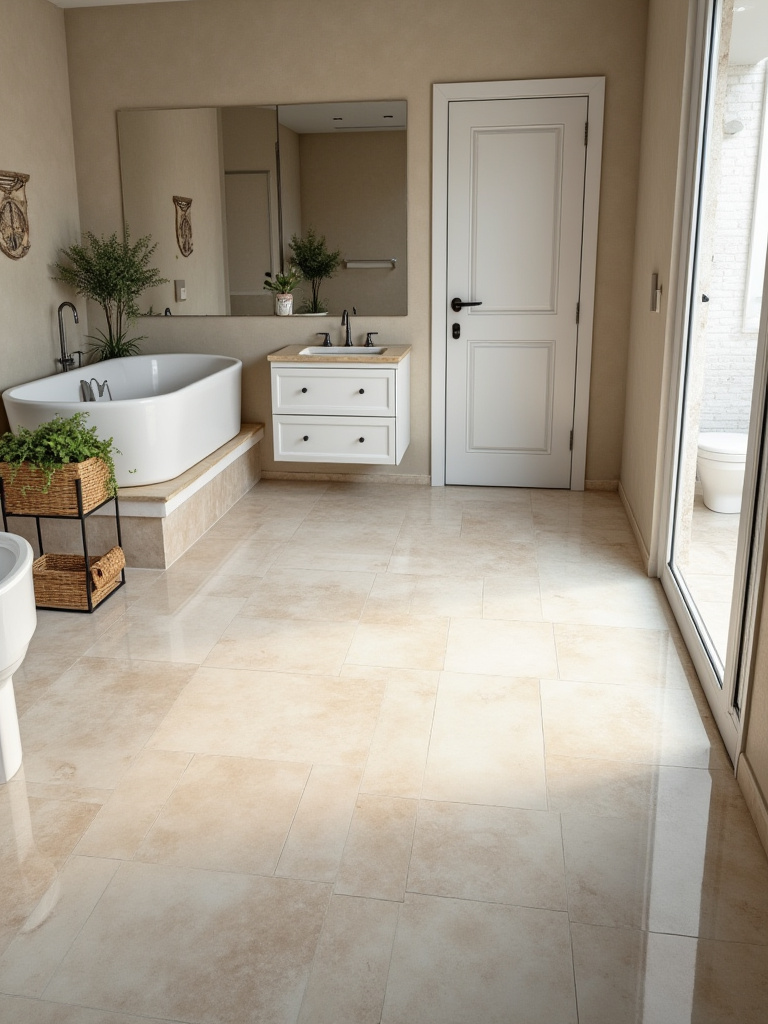
The real advantage of ceramic tile lies in its cost-effectiveness over time. While you might pay $2-4 per square foot for quality ceramic tiles, the 20-25 year lifespan means you’re looking at pennies per year of actual use. Unlike materials that require regular sealing or special cleaners, ceramic’s hard-fired surface resists stains and scratches with basic care. For small bathrooms, I often recommend 12×24 inch tiles in light colors—they create fewer grout lines to clean and reflect light to make cramped spaces feel more open.
The craftsmanship in ceramic tile production has evolved significantly, offering textures and patterns that rival much more expensive materials…
2. Select Porcelain Tile for Maximum Moisture Defense
Taking water resistance to the next level, porcelain tile is what I specify when moisture is a serious concern—think bathrooms with poor ventilation, homes in humid climates, or spaces that see heavy daily use. Porcelain’s dense composition, fired at higher temperatures than standard ceramic, results in a water absorption rate of 0.5% or less. This isn’t just marketing speak; it means water literally cannot penetrate the tile surface, protecting your subfloor from the kind of gradual moisture damage that leads to expensive structural repairs.
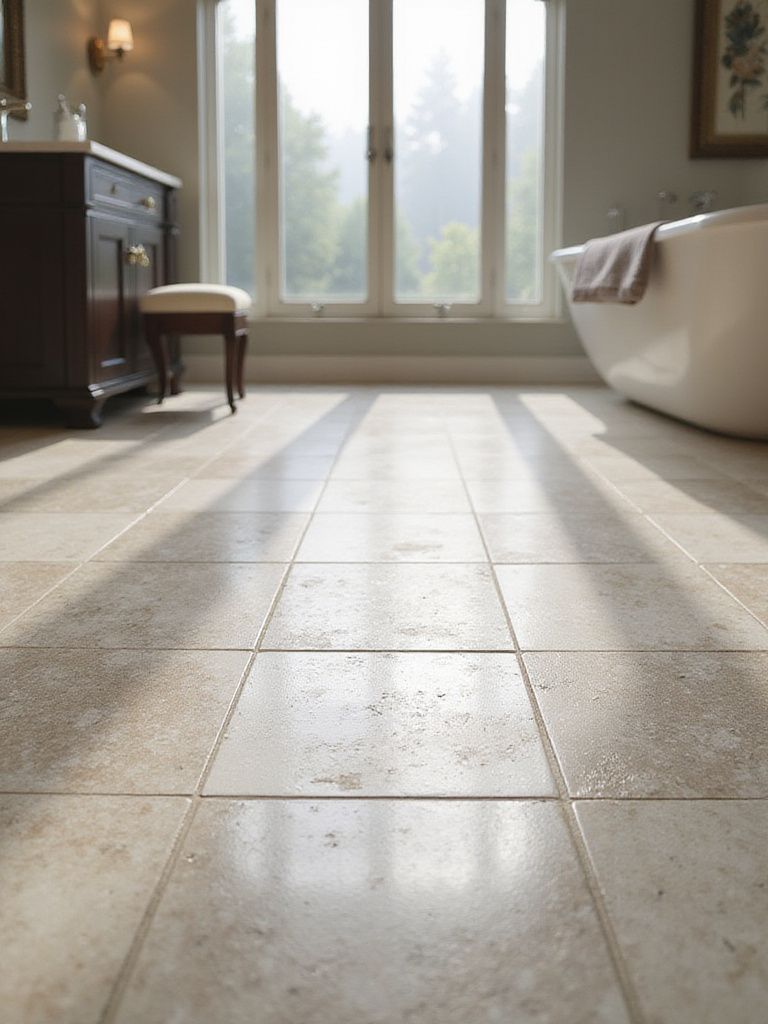
Beyond its superior moisture barrier, porcelain handles the daily reality of bathroom life exceptionally well. Soap scum, makeup spills, and cleaning products sit on the surface rather than soaking in, making cleanup effortless and preventing the permanent staining that can plague more porous materials. I’ve seen porcelain floors in busy family bathrooms maintain their appearance for over a decade with nothing more than regular mopping, while comparable ceramic tiles in the same conditions showed wear and discoloration.
What makes porcelain particularly valuable in small spaces is its ability to handle large format installations without compromising performance…
3. Install Natural Stone for Authentic Luxury That Increases Home Value
Natural stone tiles transform a bathroom from purely functional to genuinely luxurious, offering the kind of authentic beauty that synthetic materials simply cannot replicate. Each piece tells its own story through unique veining, color variations, and surface textures that make your floor a one-of-a-kind installation. When clients ask about return on investment, natural stone consistently delivers—bathroom renovations featuring quality stone can increase home value by 2-5%, with the material itself becoming a selling point that appeals to discerning buyers.
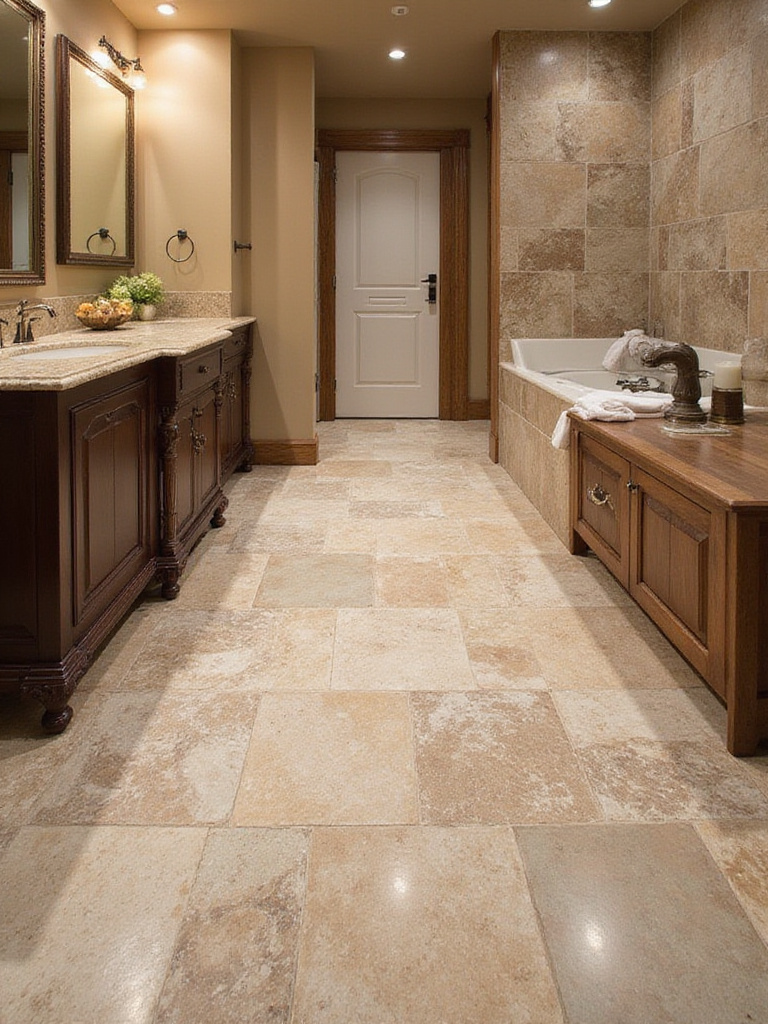
The key to success with natural stone lies in understanding its needs upfront rather than treating it like ceramic tile. Proper sealing is non-negotiable, especially in wet environments, but when done correctly, stone floors can outlast multiple generations of homeowners. I recommend honed finishes over polished for bathroom applications—they provide better slip resistance while still showcasing the stone’s natural beauty, and minor etching from acidic spills becomes far less visible than on highly reflective surfaces.
The artisans behind natural stone installations bring generations of knowledge to each project, understanding how different stones behave in various environments…
4. Opt for Marble Tile’s Timeless Elegance (With Proper Maintenance)
Marble represents the pinnacle of natural stone luxury, offering veining patterns and luminous depth that have captivated designers for centuries. No two marble tiles are identical, ensuring your bathroom floor becomes a unique work of art that transcends trends and fads. The material’s association with high-end spas and luxury hotels isn’t accidental—marble creates an atmosphere of refined sophistication that can transform even a modest bathroom into a personal retreat.
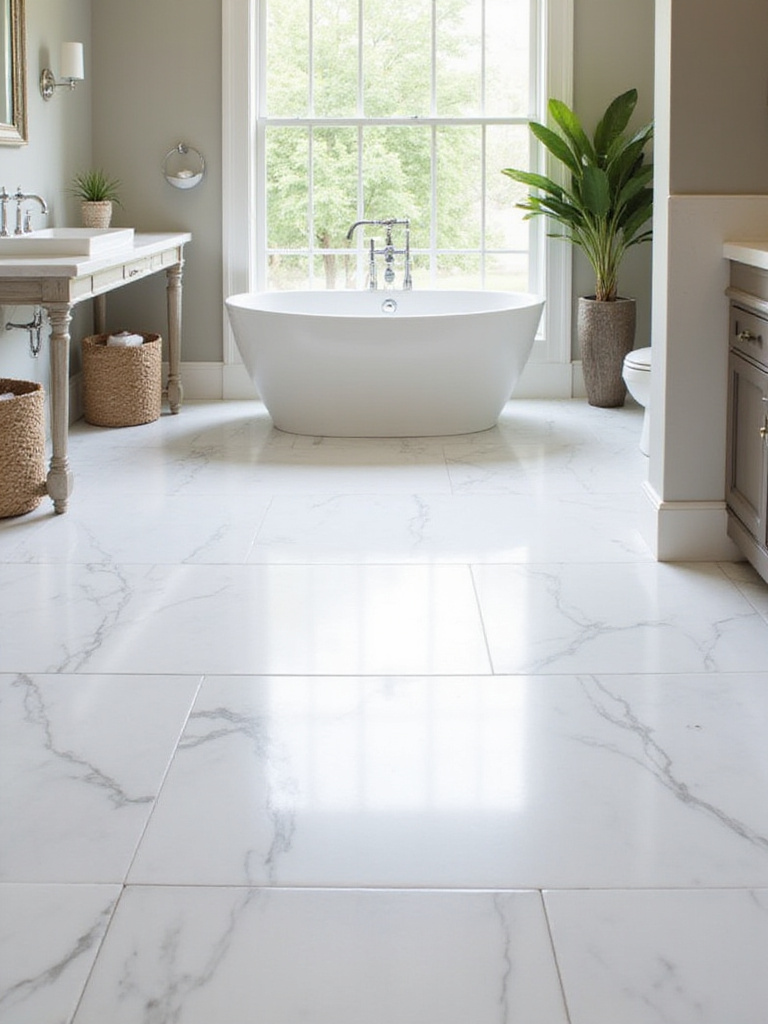
However, marble’s beauty comes with responsibility. This calcium carbonate-based stone is vulnerable to etching from acidic substances and requires consistent sealing to prevent staining. I always educate clients about proper marble care before installation: immediate spill cleanup, pH-neutral cleaners only, and professional resealing every 6-12 months depending on use. When maintained properly, marble floors develop a subtle patina that enhances their character, but neglect can lead to permanent damage that’s expensive to repair.
The unexpected pairing that always works with marble is combining it with modern fixtures and clean lines, creating contrast that highlights both elements…
5. Consider Slate Tile for Natural Texture and Superior Grip
Slate’s naturally clefted surface provides something most bathroom floors lack: inherent slip resistance that actually improves when wet. This textural quality isn’t just about safety—it adds visual depth and tactile interest that makes small bathrooms feel more dynamic and engaging. The material’s earthy tones, ranging from deep charcoals to warm purples and greens, create a spa-like atmosphere that feels grounded and calming, especially when paired with natural lighting.

From a practical standpoint, slate’s texture works overtime in small bathrooms. The varied surface naturally conceals water spots, soap residue, and minor dirt between cleanings, maintaining a cleaner appearance with less effort. Unlike smooth tiles that show every footprint and water mark, slate’s organic texture camouflages the daily evidence of bathroom use while providing the grip you need when stepping out of a shower or tub.
The visual weight of slate balances perfectly when you pair it with lighter wall colors and plenty of task lighting…
6. Use Large Format Tiles to Visually Expand Small Bathrooms
Large format tiles, typically 15 inches or larger on at least one side, are my secret weapon for making small bathrooms feel significantly more spacious. By dramatically reducing grout lines—sometimes by 70-80% compared to standard 4×4 inch tiles—these expansive surfaces create an uninterrupted visual flow that tricks the eye into perceiving more space. The fewer visual breaks across your floor, the larger and less cluttered your bathroom appears.
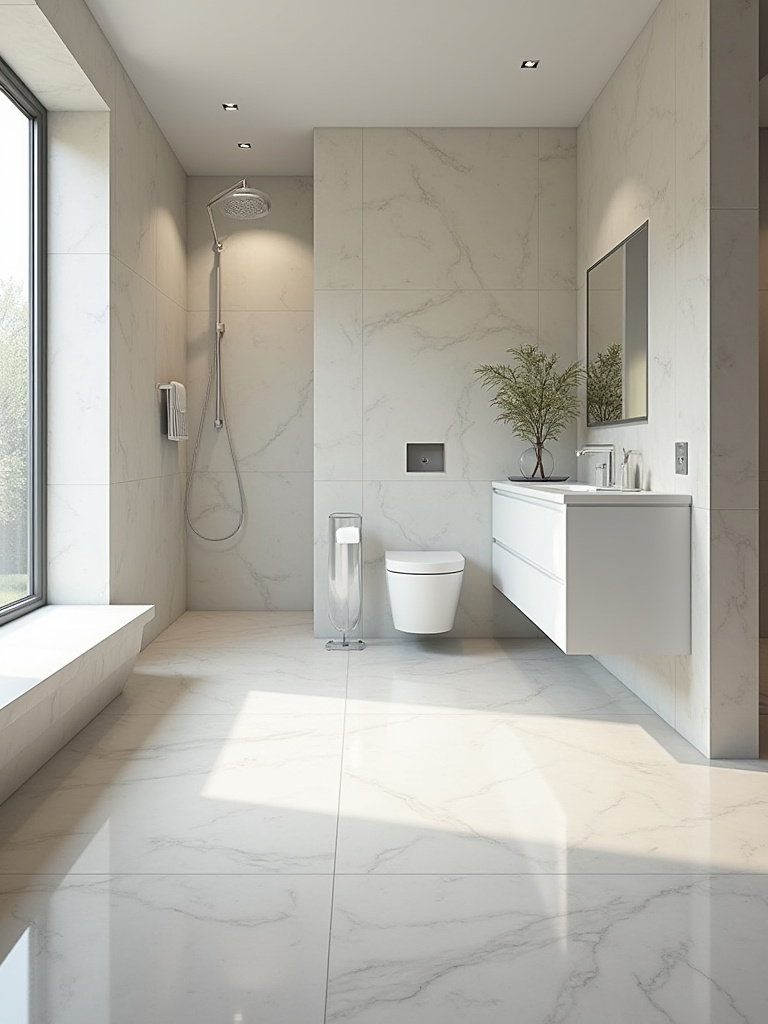
Beyond the spatial illusion, large format tiles offer practical advantages that small-space dwellers appreciate. Fewer grout lines mean dramatically less cleaning and maintenance—there are simply fewer places for mold, mildew, and soap scum to accumulate. Installation costs can sometimes offset the higher tile prices, as experienced installers can cover more area with fewer cuts and less grouting time, especially in straightforward rectangular layouts.
The composition comes together beautifully when you extend large format tiles from floor to wall, creating a seamless envelope that makes boundaries disappear…
7. Design with Mosaic Tiles for Visual Interest in Compact Spaces
Mosaic tiles offer small bathrooms something that larger formats cannot: the ability to create intricate patterns and focal points that add personality without overwhelming limited square footage. These small tiles, typically under 2×2 inches and often mounted on mesh backing, allow for gradient effects, geometric patterns, and artistic designs that transform your floor from functional surface to design statement. In powder rooms especially, a mosaic floor can become the primary decorative element that guests remember.
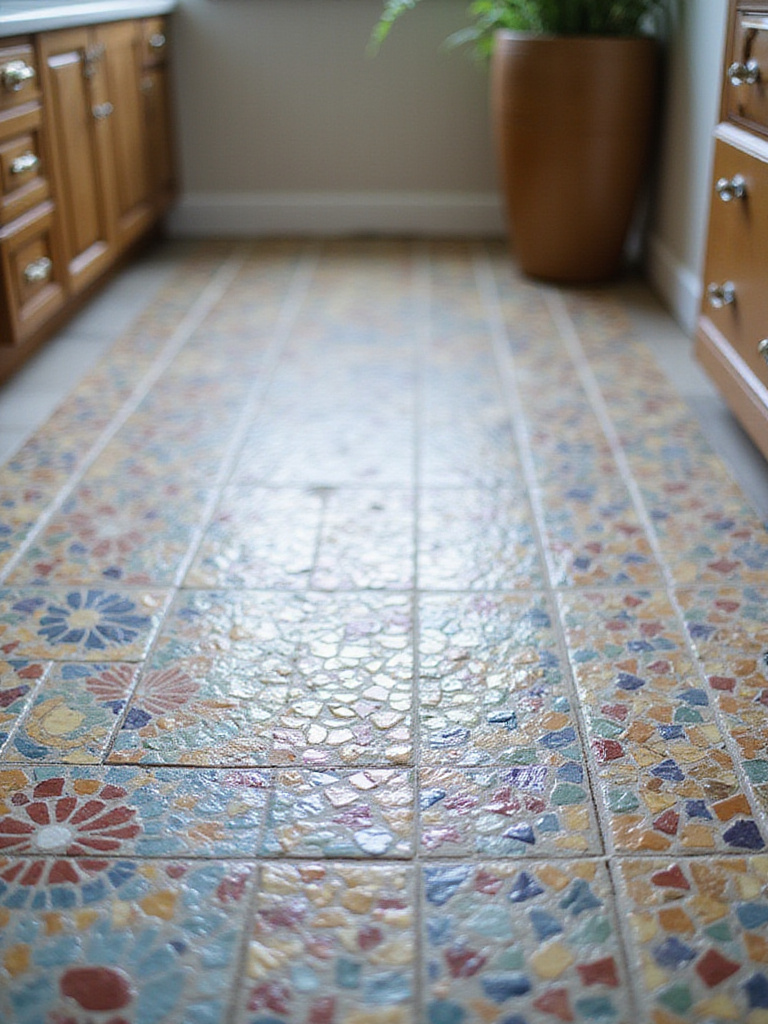
The increased grout lines that come with mosaic installations provide a significant safety benefit in wet environments. More grout means more texture and grip underfoot, reducing slip hazards when transitioning from shower to floor. This enhanced traction becomes particularly valuable in households with children or older adults, where bathroom safety is paramount. Quality mosaic tiles also resist cracking better than large rigid tiles when subjected to minor impacts or settling.
The styling mistake most people make with mosaics is choosing overly complex patterns that compete with other bathroom elements…
8. Install Subway Tiles for Versatile, Budget-Friendly Style
Subway tiles bring timeless appeal to bathroom floors while offering the flexibility to complement virtually any design style, from vintage farmhouse to sleek contemporary. Their clean, rectangular lines create visual order in small spaces without feeling busy or overwhelming, and the variety of available layouts—offset, stacked, herringbone, or basketweave—allows for customization that reflects your personal style while maintaining classic appeal.

The economic advantage of subway tiles extends beyond their modest material cost. Their popularity means wide availability, competitive pricing, and easy replacement if repairs become necessary years down the line. Installation is straightforward for experienced DIYers, and the rectangular format minimizes waste during cutting and fitting. When made from porcelain or high-quality ceramic, subway tiles deliver decades of reliable performance at a fraction of the cost of natural stone or specialty tiles.
The finishing touch that elevates subway tile floors is the careful selection of grout color, which can either blend for subtle elegance or contrast for bold definition…
9. Choose Luxury Vinyl Plank for Wood Aesthetics Without Water Worries
Luxury Vinyl Plank (LVP) has revolutionized bathroom flooring by delivering the warmth and beauty of hardwood without any of the moisture-related risks. Advanced printing and embossing technology creates wood grain patterns so realistic that distinguishing them from actual hardwood requires close inspection. This allows you to achieve the cozy, residential feel of wood floors in spaces where traditional hardwood would inevitably fail due to humidity and water exposure.
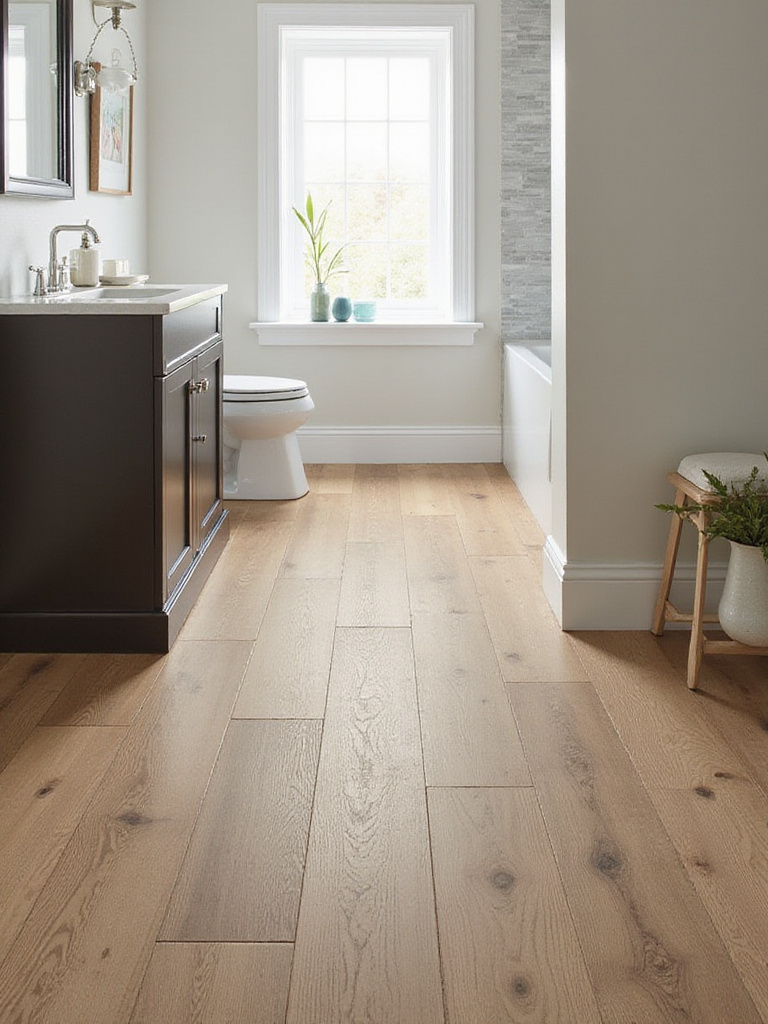
The waterproof core construction of quality LVP—whether Stone Plastic Composite (SPC) or Wood Plastic Composite (WPC)—provides complete protection against moisture penetration. Unlike engineered wood or laminate, which can swell and buckle from bathroom humidity, LVP maintains dimensional stability even when subjected to standing water. The attached underlayment in many products adds comfort underfoot and sound dampening, addressing two common complaints about hard bathroom flooring.
The unexpected environmental benefit of choosing LVP comes from its longevity and recyclability compared to frequently replaced moisture-damaged materials…
10. Install Sheet Vinyl for Maximum Waterproofing at Minimum Cost
When budget constraints are tight but comprehensive water protection remains non-negotiable, sheet vinyl delivers unmatched value. This continuous flooring material, installed in large sections with minimal seams, creates a nearly impervious barrier against moisture penetration. The seamless nature of sheet vinyl installation eliminates the multiple joints found in tile or plank systems, reducing potential failure points where water could reach the subfloor.
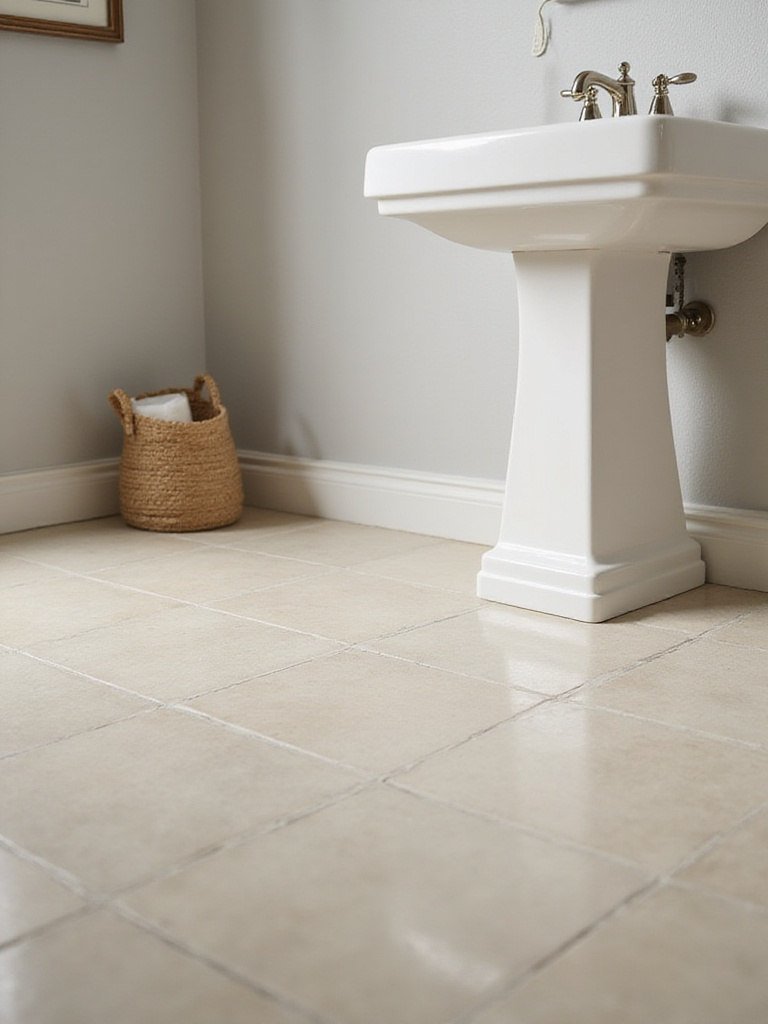
Modern sheet vinyl has evolved far beyond the thin, institutional-looking products of decades past. Today’s options feature realistic wood and stone patterns, enhanced wear layers for durability, and improved dimensional stability that resists shrinking and expansion. For rental properties or high-traffic family bathrooms where cost control is essential, sheet vinyl provides reliable performance that can last 10-15 years with basic maintenance.
The discovery of remnant rolls at flooring retailers can reduce material costs even further, sometimes bringing total project costs under $100 for small bathrooms…
11. Consider Waterproof Laminate for Wood Looks on a Budget
Waterproof laminate flooring bridges the gap between traditional laminate and luxury vinyl, offering wood aesthetics at a price point that makes sense for budget-conscious renovations. The key distinction lies in the core material—true waterproof laminate uses PVC or composite cores instead of traditional HDF (High-Density Fiberboard), providing genuine moisture resistance rather than just temporary water tolerance. This technology allows for the familiar plank format and realistic wood visuals while eliminating the swelling and buckling that plague standard laminate in humid environments.
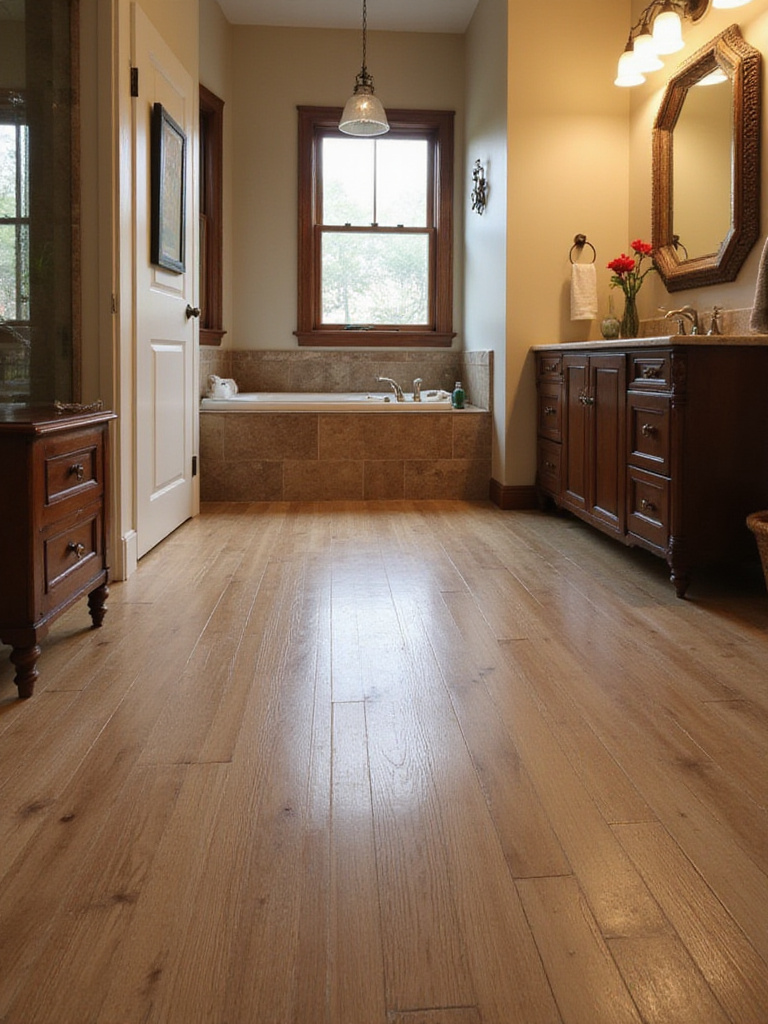
The installation advantages of waterproof laminate appeal to DIY renovators and professionals alike. Click-lock systems install quickly without adhesives or special tools, potentially completing a small bathroom floor in a single day. The floating installation method also accommodates minor subfloor imperfections better than rigid tiles, reducing preparation time and costs. When properly installed with appropriate perimeter sealing, waterproof laminate can provide years of reliable service at 30-50% less cost than comparable wood-look tile options.
The sustainable journey of waterproof laminate involves recycled content in many products, reducing environmental impact while delivering performance…
12. Pour Polished Concrete for Industrial Style and Ultimate Durability
Polished concrete creates a seamless, modern aesthetic that transforms bathrooms into sleek, spa-like spaces while delivering unmatched durability and longevity. The grinding and polishing process produces a surface that’s both beautiful and practical—no grout lines to clean, no individual tiles to replace, and a finish that can last the lifetime of your home with proper maintenance. The industrial aesthetic works particularly well in urban lofts and contemporary homes where minimalist design is valued.

The practical benefits of polished concrete extend beyond its striking appearance. When properly sealed with penetrating and topical coatings designed for wet areas, concrete becomes highly resistant to water, stains, and chemical damage. The thermal mass properties make it an excellent choice for radiant floor heating systems, distributing warmth evenly and efficiently. Light reflection from polished surfaces can also brighten small bathrooms, making them feel larger and more welcoming.
The artisan’s approach to polished concrete involves multiple grinding stages, each progressively finer, creating the desired sheen level while ensuring durability…
13. Apply Epoxy Flooring for Seamless, Chemical-Resistant Performance
Epoxy flooring systems create completely seamless, non-porous surfaces that excel in bathroom environments where moisture and chemical resistance are paramount. The multi-layer application process—primer, base coat, and topcoat—bonds directly to prepared concrete substrates, forming a monolithic surface without joints or seams where water could penetrate. This seamless quality eliminates the maintenance challenges associated with grout lines while providing superior protection against water damage and mold growth.
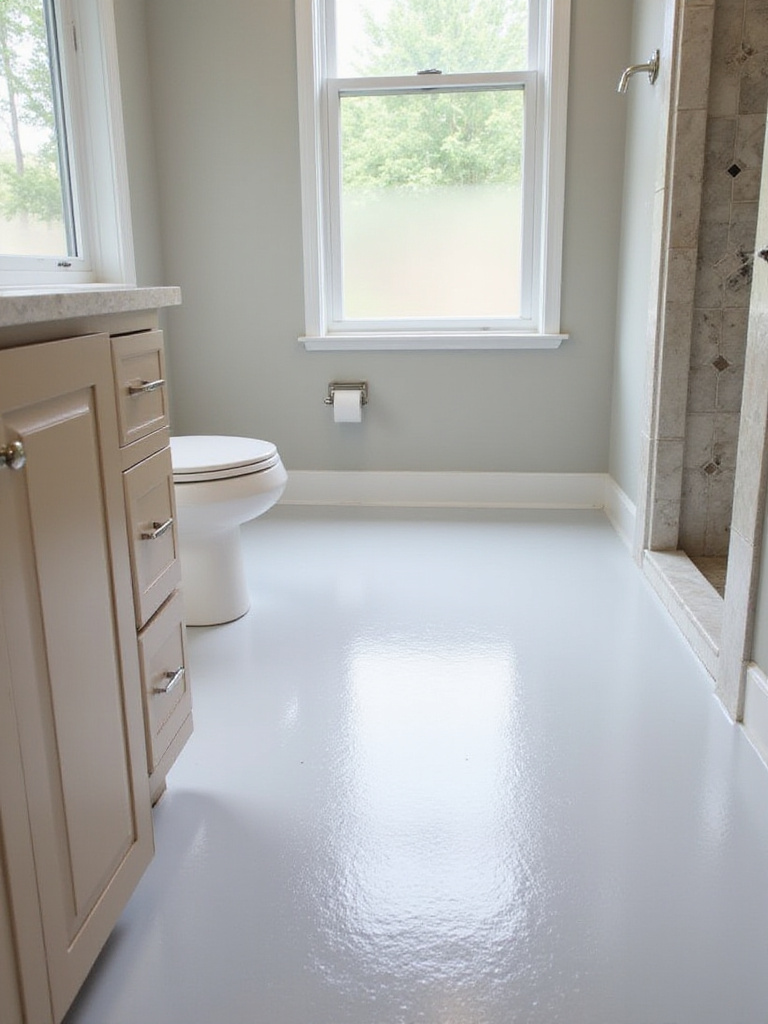
The chemical resistance of properly applied epoxy surpasses most traditional flooring materials, standing up to harsh cleaning products, cosmetics, and personal care items without staining or degrading. The surface remains easy to clean and sanitize, requiring only basic mopping to maintain its appearance. Decorative options including metallic pigments, color flakes, and custom patterns allow for unique aesthetic effects that rival high-end tile installations while providing superior performance characteristics.
The environmental story behind epoxy flooring includes its longevity factor—properly installed systems can last 15-20 years, reducing replacement frequency and associated waste…
14. Understand Engineered Wood’s Bathroom Limitations and Alternatives
Engineered wood flooring presents a complex decision for bathroom applications, offering the authentic beauty of hardwood while providing more dimensional stability than solid wood products. The layered construction—typically a hardwood veneer over a plywood or HDF core—resists expansion and contraction better than solid planks, making it theoretically more suitable for humid environments. However, the reality of bathroom use often exceeds even engineered wood’s improved moisture tolerance.

The critical factor in engineered wood performance is understanding the difference between improved moisture resistance and true waterproofing. While engineered products handle humidity fluctuations better than solid wood, they remain vulnerable to direct water contact, splashes, and prolonged exposure to bathroom steam. Most manufacturers specifically exclude bathroom installations from their warranties, recognizing the challenging environment that even improved wood products struggle to handle long-term.
For those hesitant about abandoning wood aesthetics entirely, modern waterproof alternatives now replicate wood grain so accurately that the visual difference is negligible…
15. Consider Bamboo Flooring’s Eco-Friendly Potential (Choose Carefully)
Bamboo flooring offers an environmentally conscious alternative to traditional hardwood, with certain engineered varieties providing improved moisture resistance suitable for bathroom applications. The key lies in selecting strand-woven bamboo with specialized water-resistant treatments rather than standard horizontal or vertical bamboo products. These engineered versions, often incorporating HDF cores or waterproof coatings, can withstand bathroom humidity while maintaining bamboo’s distinctive appearance and renewable resource benefits.
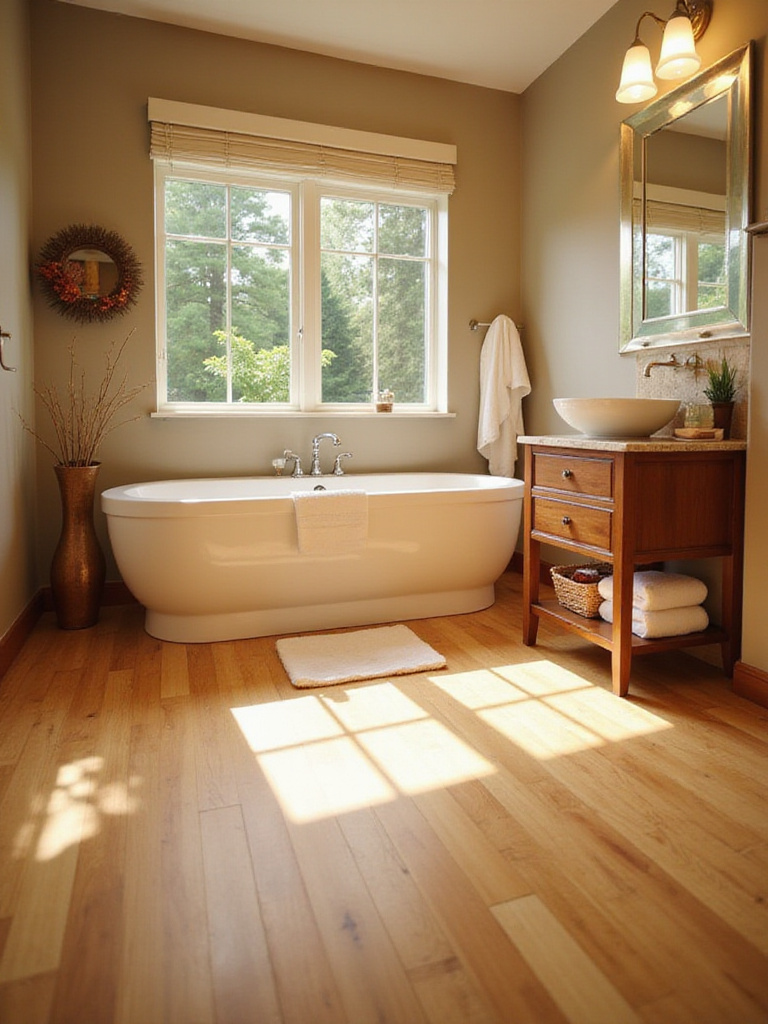
The sustainability story of bamboo is compelling—it’s technically a grass that regenerates rapidly, reaching harvest maturity in 3-5 years compared to decades for hardwood trees. Strand-woven varieties achieve density ratings that exceed many traditional hardwoods on the Janka scale, providing durability that justifies the investment. However, success in bathroom applications depends heavily on proper installation, including comprehensive sealing of all edges and transitions to prevent moisture infiltration.
The maker’s journey from bamboo forest to finished flooring involves careful selection of mature culms and precise manufacturing to achieve the density needed for wet area performance…
16. Install Cork Flooring for Natural Warmth and Comfort
Cork flooring brings unique qualities to bathroom environments: natural warmth underfoot, inherent antimicrobial properties, and a soft, cushioned surface that’s comfortable for extended standing. The cellular structure of cork provides excellent thermal insulation, making bathroom floors noticeably warmer than tile or stone alternatives. This warmth factor becomes particularly valuable in colder climates or for households where barefoot comfort is a priority.

The natural properties of cork extend beyond comfort to practical benefits in bathroom settings. Suberin, the waxy substance in cork’s cell walls, provides natural resistance to mold and mildew growth, while the material’s acoustic dampening qualities reduce noise transmission—a consideration in multi-story homes. However, cork’s success in bathrooms depends entirely on proper sealing with marine-grade or high-quality water-based polyurethanes applied in multiple coats to create an effective moisture barrier.
The traditional methods used in cork harvesting actually benefit the trees, as bark removal encourages new growth and extends tree lifespan…
17. Use Rubber Flooring for Ultimate Safety and Impact Resistance
Rubber flooring, while unconventional for residential bathrooms, provides unmatched slip resistance and safety characteristics that make it worthy of consideration, especially for households prioritizing accessibility or aging-in-place modifications. The material’s inherent grip actually improves when wet, achieving DCOF ratings that far exceed minimum safety standards for wet areas. This superior traction, combined with impact absorption that reduces injury risk from falls, creates the safest possible bathroom floor surface.

Beyond safety, rubber flooring offers practical advantages that appeal to busy households. The material resists dents and damage from dropped objects, maintains its appearance under heavy traffic, and provides acoustic dampening that reduces noise transmission. Modern rubber formulations and installation techniques have moved far beyond the utilitarian gym aesthetic, with textured surfaces and color options that create sophisticated, spa-like environments while delivering uncompromising performance.
The innovation narrative in rubber flooring involves recycled content from tires and other sources, creating sustainable products with exceptional durability…
18. Prioritize High Water Resistance Ratings for Long-Term Success
Regardless of aesthetic preferences or budget constraints, prioritizing materials with proven high water resistance ratings represents the most important decision factor for bathroom flooring success. This specification protects your investment by preventing the costly subfloor damage, mold remediation, and premature replacement that result from moisture infiltration. Understanding the difference between water-resistant and waterproof classifications helps ensure you select materials truly suited for bathroom environments.
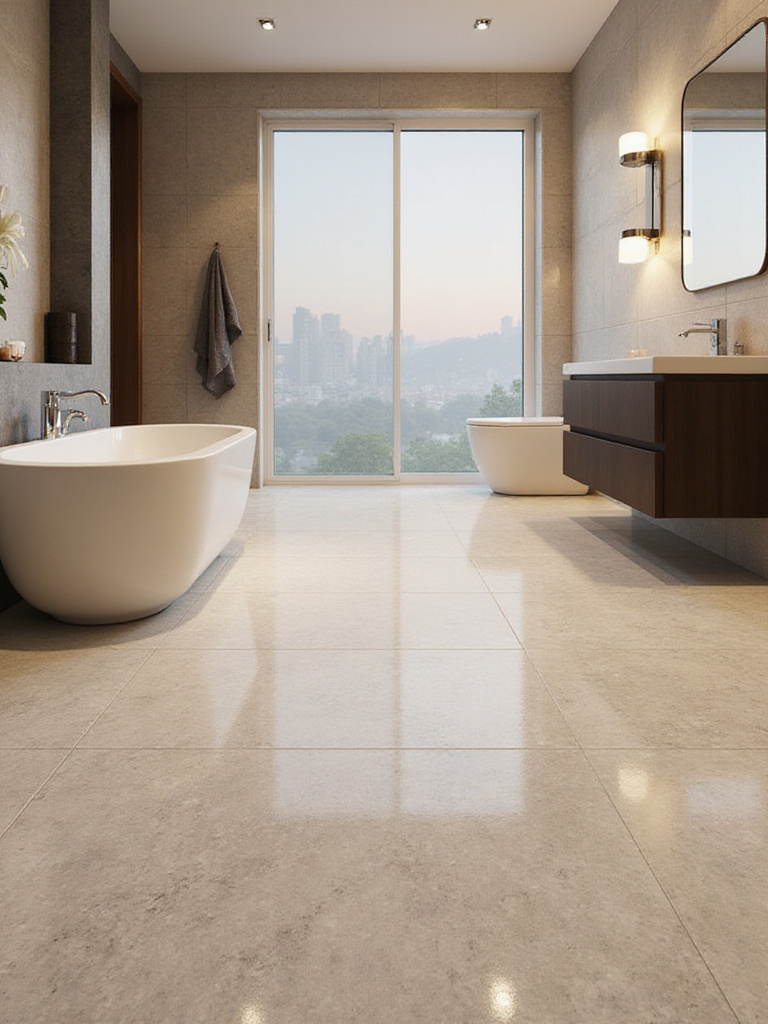
The financial impact of choosing inadequately water-resistant materials extends far beyond the initial flooring cost. Water damage claims average over $11,000 according to insurance industry data, while mold remediation can cost thousands more. Properly water-resistant flooring prevents these issues while extending service life by 10-20 years compared to materials that fail due to moisture exposure. The peace of mind that comes with truly waterproof flooring allows you to enjoy your bathroom without constant worry about long-term damage.
The testing standards that determine water resistance ratings provide objective measures for comparing materials across different categories and price points…
19. Select Textured Surfaces for Essential Slip Prevention
Safety considerations in bathroom flooring extend beyond water resistance to include slip prevention, making surface texture a critical specification for any bathroom floor material. The Dynamic Coefficient of Friction (DCOF) rating provides objective measurement of slip resistance, with ANSI A326.3 recommending minimum values of 0.42 for wet interior surfaces. Choosing materials that meet or exceed this threshold significantly reduces the risk of slip-related injuries that send thousands to emergency rooms annually.
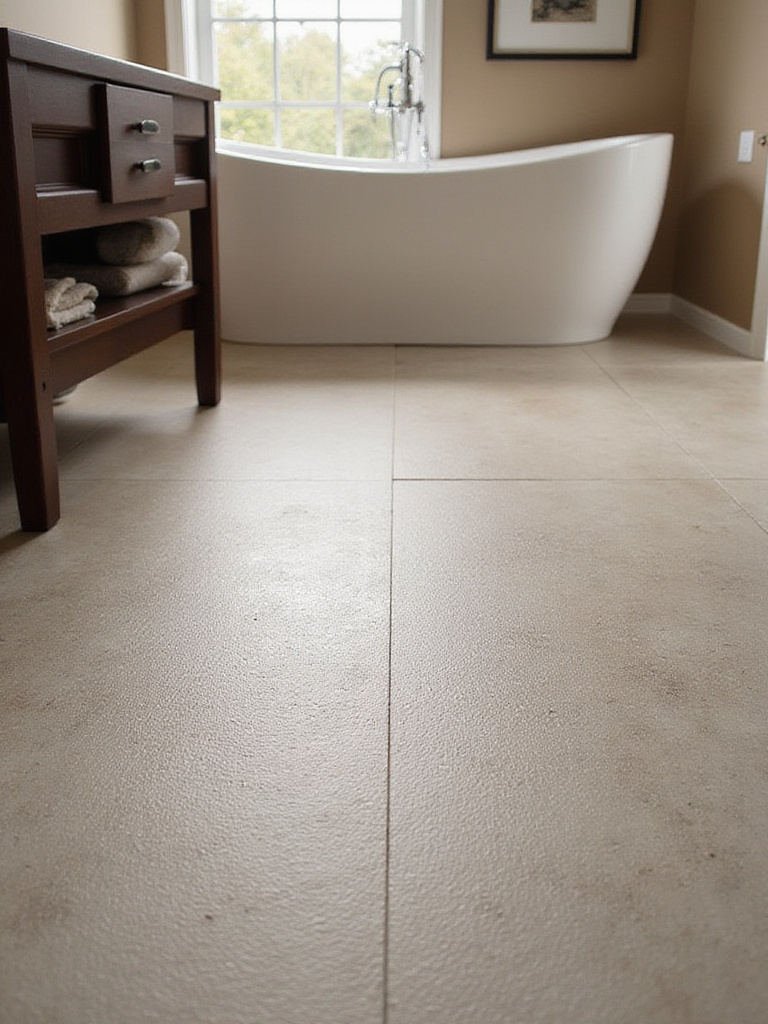
Textured surfaces achieve slip resistance through various methods: natural stone’s inherent variation, ceramic tile’s matte glazes, vinyl’s embossed patterns, or rubber’s molded grip surfaces. The key is selecting texture that provides adequate traction without creating cleaning difficulties or comfort issues for bare feet. Smaller tile formats with more grout lines also contribute to slip resistance, as grout typically provides better traction than the tile surface itself.
The professional styling approach involves balancing slip resistance with aesthetic appeal, ensuring safety doesn’t compromise the design vision…
20. Discover Budget-Friendly Options Under $5 Per Square Foot
Achieving a dramatic bathroom transformation doesn’t require premium materials—numerous durable, attractive flooring options cost less than $5 per square foot while delivering reliable performance in wet environments. These budget-friendly bathroom floor ideas enable complete renovations for hundreds rather than thousands of dollars, making updates accessible even during tight financial periods. The key lies in understanding which materials offer the best combination of cost, durability, and water resistance within budget constraints.
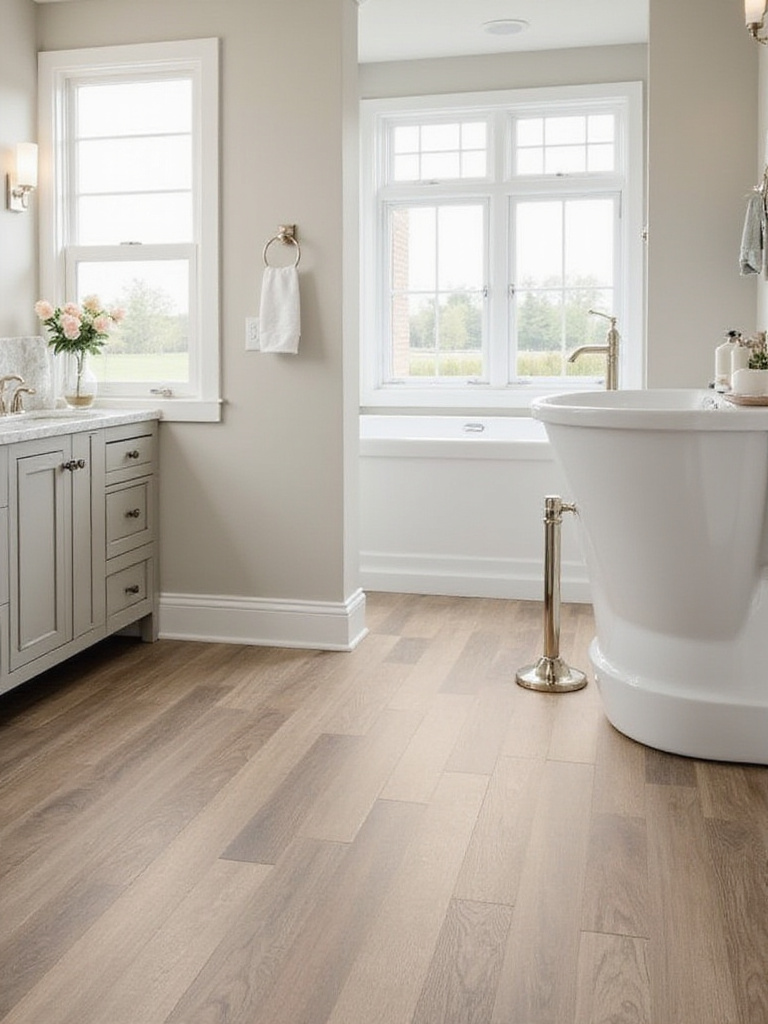
Sheet vinyl and basic luxury vinyl tile (LVT) lead the budget category, often available for $1-3 per square foot while providing excellent water resistance and realistic appearance options. Ceramic tile remnants and closeout styles frequently offer premium materials at significant discounts, sometimes reducing costs by 50-70% below regular pricing. These savings allow budget-conscious renovators to achieve high-end looks without compromising on essential performance characteristics like water resistance and durability.
The discovery process for budget materials involves timing purchases around retailer clearance events and being flexible about exact colors or patterns…
21. Identify DIY-Friendly Materials for Maximum Cost Savings
Selecting flooring materials suitable for DIY installation can reduce total project costs by 40-60% while providing the satisfaction of personally transforming your space. However, not all bathroom flooring options are equally suited for homeowner installation, particularly given the moisture considerations and precision required for wet area applications. Understanding which materials offer the best combination of DIY-friendliness and bathroom suitability helps maximize both cost savings and long-term success.

Luxury Vinyl Plank (LVP) and Luxury Vinyl Tile (LVT) with click-lock systems represent the most DIY-friendly options for bathroom applications. These materials require minimal specialized tools, install without adhesives, and allow for easy corrections during the learning process. Sheet vinyl, while requiring more precision in measuring and cutting, offers another accessible option for motivated DIYers willing to invest time in careful preparation and installation.
The professional techniques that ensure DIY success include proper subfloor preparation, accurate measurement and templating, and understanding expansion requirements…
22. Incorporate Radiant Floor Heating for Enhanced Comfort
Radiant floor heating transforms cold bathroom floors into sources of luxurious warmth, creating spa-like comfort while potentially improving energy efficiency. Electric systems, most practical for bathroom renovations, install directly beneath the flooring material, providing consistent surface temperatures that eliminate the shock of cold tiles on bare feet. This comfort enhancement becomes particularly valuable in colder climates or for households where bathroom comfort is a priority.
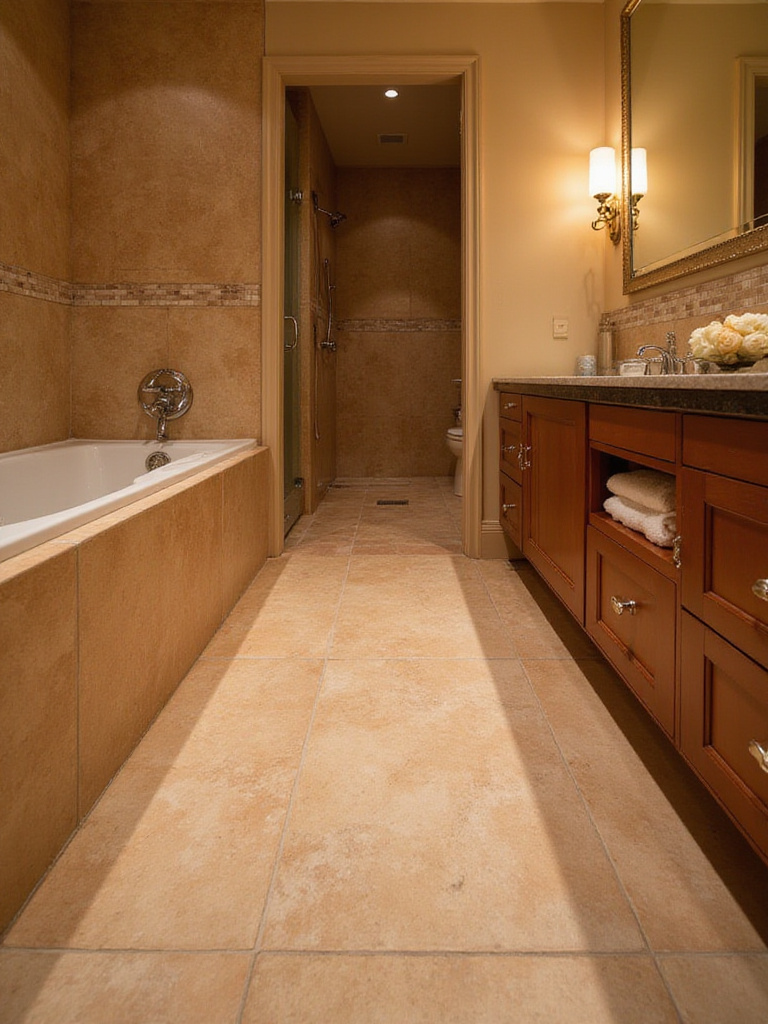
The energy efficiency potential of radiant heating comes from its ability to provide perceived warmth at lower air temperatures, potentially reducing overall heating costs by 10-15% in well-insulated spaces. The even heat distribution eliminates cold spots and drafts common with forced-air systems, while the lack of air movement reduces dust circulation. Installation during flooring renovation adds minimal complexity while providing decades of enhanced comfort and potential energy savings.
The technical requirements for radiant heating include proper insulation beneath the system and compatible flooring materials that conduct heat effectively…
23. Choose Sustainable Materials for Environmental Responsibility
Environmentally conscious homeowners can select bathroom floor ideas that minimize environmental impact while maintaining performance and aesthetic standards. Sustainable flooring considers the entire lifecycle: resource extraction, manufacturing processes, transportation, durability, and end-of-life disposal or recycling. These choices reduce embodied carbon, improve indoor air quality through low-VOC materials, and support responsible manufacturing practices.
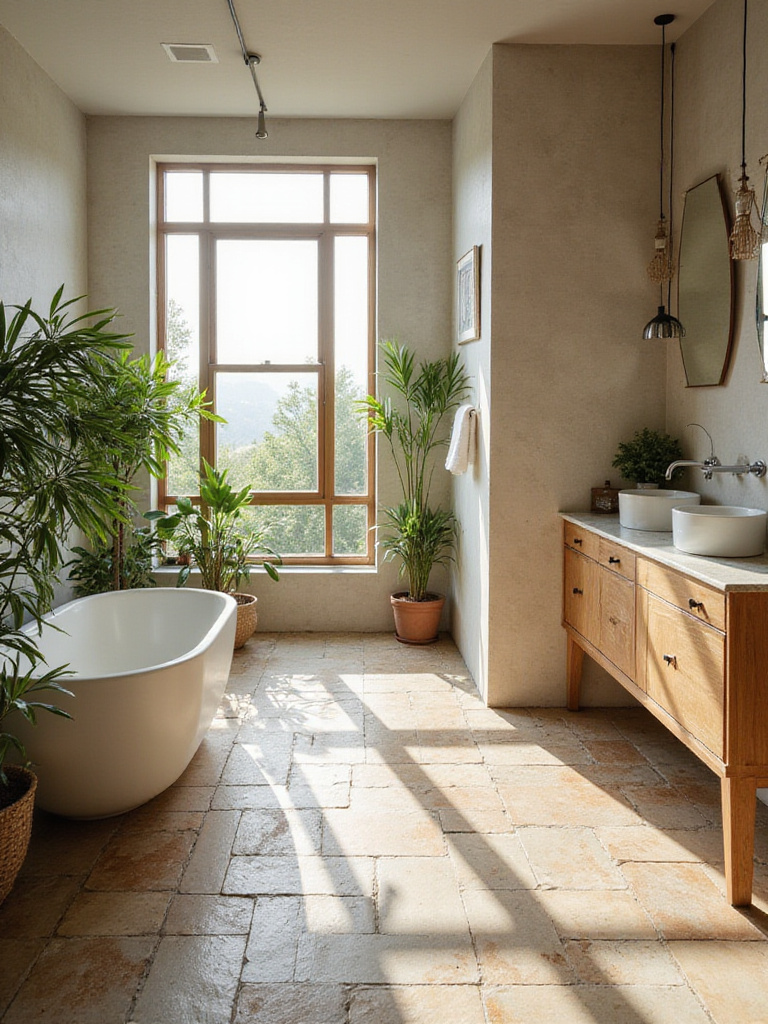
Reclaimed materials, rapidly renewable resources like bamboo and cork, and products with high recycled content offer paths to sustainable bathroom flooring. Durability becomes a key sustainability factor—materials lasting 20-30 years avoid the environmental cost of frequent replacement while providing better long-term value. Some manufacturers now provide Environmental Product Declarations (EPDs) that quantify environmental impact, enabling informed comparisons between options.
The circular economy approach to flooring considers not just initial environmental impact but also the material’s journey through use and eventual recycling or disposal…
Conclusion
Selecting the right bathroom floor ideas for your space requires balancing multiple priorities: water resistance, safety, budget, style preferences, and installation requirements. Throughout this guide, we’ve explored options ranging from budget-friendly sheet vinyl to luxurious natural stone, each offering distinct advantages for different situations and priorities. The key insight is that there’s no single “best” material—only the best choice for your specific circumstances, needs, and long-term goals.
Remember that proper installation matters as much as material selection. Even the most water-resistant flooring can fail if installed incorrectly, while budget materials can provide decades of service when properly prepared and maintained. Don’t underestimate the importance of subfloor preparation, appropriate adhesives, and correct sealing techniques—these factors often determine success or failure more than the flooring material itself.
Take time to gather samples, test them in your actual lighting conditions, and consider how they’ll perform with your household’s specific usage patterns. Whether you’re tackling a DIY weekend project or working with professional installers, the investment in proper planning and quality materials will reward you with a bathroom floor that serves you well for years to come, providing both daily comfort and long-term value.
